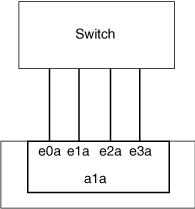Dynamic multimode interface group
Dynamic multimode interface group implement Link Aggregation Control Protocol (LACP) to communicate group membership to the directly attached switch. LACP enables you to detect the loss of link status and the inability of the node to communicate with the direct-attached switch port.
Dynamic multimode interface group implementation in ONTAP complies with IEEE 802.3 AD (802.1 AX). ONTAP does not support Port Aggregation Protocol (PAgP), which is a proprietary link aggregation protocol from Cisco.
A dynamic multimode interface group requires a switch that supports LACP.
ONTAP implements LACP in nonconfigurable active mode that works well with switches that are configured in either active or passive mode. ONTAP implements the long and short LACP timers (for use with nonconfigurable values 3 seconds and 90 seconds), as specified in IEEE 802.3 AD (802.1AX).
The ONTAP load balancing algorithm determines the member port to be used to transmit outbound traffic, and does not control how inbound frames are received. The switch determines the member (individual physical port) of its port channel group to be used for transmission, based on the load balancing algorithm configured in the switch's port channel group. Therefore, the switch configuration determines the member port (individual physical port) of the storage system to receive traffic. For more information about configuring the switch, see the documentation from your switch vendor.
If an individual interface fails to receive successive LACP protocol packets, then that individual interface is marked as lag_inactive in the output of ifgrp status command. Existing traffic is automatically rerouted to any remaining active interfaces.
Dynamic multimode interface groups should be configured to use the port-based, IP-based, MAC-based, or round robin load balancing methods.
In a dynamic multimode interface group, all interfaces must be active and share a single MAC address.
The following figure is an example of a dynamic multimode interface group. Interfaces e0a, e1a, e2a, and e3a are part of the a1a multimode interface group. All four interfaces in the a1a dynamic multimode interface group are active.
